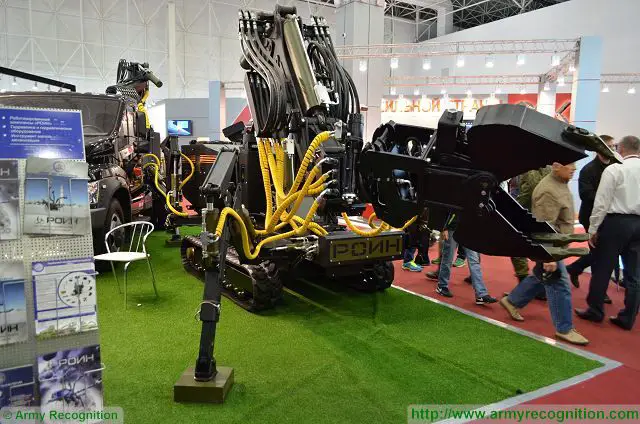|
|
|||
|
Military Defense Industry Technology - R-300 Robot
|
|||
|
|
|||
| Engineer units of Russian army will receive R-300 robot UGV Unmmaned Ground Vehicles. | |||
|
Engineer units of the Russian Army Railroad Corps will be fielded with the unique R-300 robotic system. The R-300 developed by machinebuilding corporation Intekhros conducts rescue, repairs pipelines and communication lines and defuses ammunition even at an ambient temperature of -50°C, according to the Izvestia daily.
|
|||
|
|
|||
 R-300 engineer robotic system (UGV Unmanned Ground Vehicle) at Army-2016 International Military Technical Forum near Moscow, Russia, September 2016. |
|||
|
|
|||
|
The advanced robot is a small all-terrain vehicle fitted with rubber tracks and a special crane-manipulator. The latter’s upper segment, which agility is on a par with that of the human hand, mounts detachable equipment. The manipulator’s unique agility enables the R-300 to perform precise work in confined spaces, i.e. wells of service lines, etc.
"The R-300 has passed the factory tests, proving its design characteristics," the Intekhros spokesman, Pavel Chernousov, told Izvestia. "Now, we are in talks with the Defense Ministry. A decision has been made to continue our cooperation, and we intend to launch the delivery of our devices to the military." According to Chernousov, a scaled-down version of the robot has been acquired by the emergency response center of Russia’s Rosatom Corporation, and the Moscow subway has bought one robot with the tracks replaced with bogies. The designation R-300 means that 300 various add-on tools can be attached to the robot’s manipulator. To handle unexploded ordnance (UXO), the R-300 is fitted with a special clamp with sensors controlling the squeeze rate. This lets the robot lift the UXO without crushing it. When earthmoving works are due, the robot is equipped with a digging bucket and an auger. A hydraulic hammer and a breaker are attached when buildings have to be pulled down. The R-300 handles cargo with the use of a hook grab and a claw. |
|||
|
|
|||
 |
|||
|
|
|||
|
The R-300’s manipulator, which measures 6 m fully extended, lifts objects weighing up to 3 tons. The robot itself is compact enough, with its length exceeding 2.5 m a little, its width being 2 m and its weight standing at 4.5 tons. To prevent the system from tipping over while moving heavy objects, it has four supports fixing it in place in a reliable fashion.
The core of the R-300 is its small-size petrol engine. The solution maximizes the robot’s self-contained operating capability, maintainability and low-temperature operating capability. The batteries of electric motors go flat in cold weather in no time and can break down by swelling during long downtime. "The Arctic environment is extremely adverse to not only human health, but infrastructure as well. At -40°C, metals become rather fragile, increasing the probability of failures several-fold," expert Oleg Zheltonozhko tells Izvestia. "Recovery and repair in the Arctic may turn out to be a true ordeal to military maintainers. Robots similar to the R-300 may well offer them several advantages under such conditions. The robot’s physical strength is a far cry from that of man, and a single soldier using a robot will be able to do the job currently requiring a whole unit." According to the expert, unlike man, the robot can remain in the cold for a virtually unlimited period, allowing its operators to fix it in several hours by working in shifts without risking frostbite, according to the Izvestia daily. |
|||
|
|
|||
|
© Copyright 2017 TASS. All rights reserved. This material may not be published, broadcast, rewritten or redistributed.
|
|||














